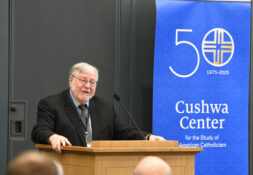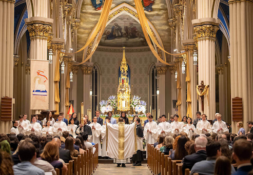Tuning in to ancient and modern debates on the modes of receiving Communion
According to the Catechism of the Catholic Church, when we receive the Eucharist at Mass, we receive “the source and summit of Christian life.” Saint Maximilian Kolbe suggested, “If angels could be jealous of men, they would be so for one reason: Holy Communion,” as it is the reception of the Body, Blood, Soul, and Divinity of Christ Himself. Even though the Eucharist is central to the lives of Catholics, the faithful often receive it in different ways, namely, on the tongue and in the hand. Why, then, are there different modes of receiving Communion? What modes are recommended by the Vatican? Why does the mode of reception even matter?
There was disagreement even in the early Church about whether Communion was to be received in the hand or on the tongue. One notable source in favor of reception in the hand is Saint Cyril of Jerusalem’s Catechetical Lectures; however, he simultaneously promoted practices such as touching the Eucharist to one’s eyes before reception. In any case, the source’s authenticity is debated. The earliest reliable source on the subject is Saint Basil of Caesarea, who considered reception on the tongue permissible only in cases where clergy were absent, such as for the Desert Fathers. However, he indicates that this practice had spread to the laypeople in Alexandria and Egypt at large. Soon after, the Council of Saragossa in 380 condemned reception in the hand, but around the same time Saint John Chrysostom wrote that such practice was standard.
Popes and synods throughout antiquity have strongly favored reception on the tongue. In a sermon from the fifth century, Pope Saint Leo the Great described the Eucharist as that which “is taken in the mouth.” There is also a story of Pope Saint Gregory the Great in the sixth century placing the Eucharist on the tongue of a mute man, which healed him. Like the aforementioned Council of Saragossa, the Synod of Rouen around 650 also denounced the practice of receiving in the hand. So why, then, is this the common modern mode of receiving Communion?
It is only recently that attention has returned to reception in the hand. Blessed Pope Paul VI did not think that reception in the hand should be made the norm but conceded that it could be acceptable under special circumstances, in keeping with the tradition of St. Basil. Paul VI believed that reception on the tongue best preserved the reverence of the Eucharist and best emphasized our total reliance on God’s mercy. For this reason, he only formally permitted reception on the tongue in 1969. It was to be introduced gradually, and it only extended as an option to those who were properly catechized so as not to cause irreverence or confusion. Yet reception on the tongue was to remain the norm, even in places where reception in the hand was common. Moreover, the Pope explicitly said that no communicant should be denied reception on the tongue if he or she desired it. Some national councils did not accept reception in the hand for a long time (Argentina did not permit it until 1996). In addition, others, including Pope Saint John Paul II, would only distribute Communion on the tongue.
Overall, this is just a quick introduction to why we may encounter both types of reception at the Mass today. Yet the question remains, does the manner in which we receive the Eucharist matter? The fact that there are only two canonically approved modes of reception in the Latin Rite, and that these modes were (and remain) hotly debated, scrutinized, and documented, suggests that the answer must be yes. When it comes to our interior disposition and expression of reverence, how we receive the Eucharist matters because receiving the Presence of Christ matters. As Jesus says in the Gospel of John, “Whoever eats my flesh and drinks my blood has eternal life.” At the same time, the Vatican warned against making the Eucharist “an occasion of discord between members of the faithful.” Ultimately, no matter how we receive the Eucharist, we experience a profound encounter with the fullness of Christ. All forms of Communion reception, regardless of mode, must bear this in mind.
This article was brought to you by the Theology Club’s Zossima Project: Making prayer an education. For a complete works cited, please email zossimaprojectnd@gmail.com. Thank you for your readership.






Leave a Reply